在大规模轨道交通建设中,如何准确预测和控制隧道开挖引起的地面沉降一直是研究的热点与难点. 地层损失是引起地面沉降最主要的因素之一,是指隧道施工过程中实际开挖土体体积和竣工隧道体积之差,工程上常用地层损失率表示[1]. 地层损失率是指单位土体损失量与土体实际开挖体积的比值,可以综合反映施工方法、工程地质、水文地质、施加支护的时间、施工管理质量和施工技术水平对地面沉降的影响. 马险峰等[2]利用离心模型试验,对隧道施工引起的地层损失率进行模拟;结果显示,地层损失率越大,施工期和工后地面沉降越大. 通过控制地层损失率,可以将地面沉降控制在所需标准之内,对地层损失率的研究具有重要的工程意义和借鉴价值.
Peck[3]首次提出地层损失的概念,在不排水条件下,利用Peck公式反分析,可以得到地层损失率与最大沉降、地面沉降槽宽度系数以及开挖半径之间的关系. 此后,国内外学者进一步研究地层损失. Rowe等[4-5]提出间隙参数与地层损失率的表达式. Clough等[6-8]建立黏性土地层中地层损失率与稳定系数[9]的关系式. 在实际工程中,以上解 析方法都存在一定的适用条件,因此基于实际工程实测资料的统计分析更重要. Mair等[10-12]统计分析英国地区的大量实测资料,结果显示该地区地层损失率砂土为0.5%,软土为1%~2.5%;Fargnoli等[13] 分析得到无黏性土层的地层损失率为0.27%~ 0.82%. Zhang等[14]给出成都砂卵石的地层损失率均值为0.87%. 韩煊等[15-18]收集国内隧道施工过程 中的实测数据,研究不同施工方法隧道施工诱发的地面沉降规律,分析施工参数的分布规律及变化特征.
通过已有研究可以看出,地层损失率对于控制隧道施工引起的地面沉降具有非常重要的意义. 地层损失率解析法有一定的局限性,根据已有的工程实测数据,利用Peck公式进行反分析,可得地层损失率是应用最广泛的方法. 本文在前人研究的基础上,收集大量国内公开发表的不同地区不同隧道施工方法引起的地面沉降实测数据,利用Peck公式反分析的方法获得地层损失率的取值. 考虑不同地层条件,统计对比分析土压平衡盾构、泥水平衡盾构和浅埋暗挖施工方法引起的地层损失率,主要研究:1)隧道施工引起的地层损失率的取值及分布规律;2)不同隧道施工方法在不同地层条件下引起的地层损失率的异同;3)不同隧道施工方法地层损失率的影响因素.
1 隧道施工引起的地层损失率 1.1 实测数据的收集与处理国内隧道建设最主要的修建方式有盾构法(土压平衡和泥水平衡)和浅埋暗挖法,此次搜集了国内23个地区已公开发表的不同隧道施工方法的实测地面沉降数据.
Peck[3]提出不排水条件下的横向地面沉降估算公式:
| $ S(x) = {S_{\max }}\exp\; \left[ - {{{x^2}}}/\big({{2{i^2}}}\big)\right] , $ | (1) |
| $ {S_{\max }} = \frac{{{V_{\rm s}}}}{{i\sqrt {2{\text π}} }} , $ | (2) |
| $ {V_{\rm l}} ={{{V_{\rm s}}}}/\left({{{\text π}{R^2}}}\right) . $ | (3) |
式中:S(x)为计算点x的地面竖向沉降;x为计算点到隧道中心的水平距离;Smax为隧道中心点上方的最大地面竖向沉降;i为高斯沉降曲线反弯点到隧道中心的水平距离,一般称为地面沉降槽宽度,i=kh[12],其中k为地面沉降槽宽度系数,h为隧道轴线埋深;Vs为隧道施工引起的单位长度地层损失;R为隧道的开挖直径;Vl为隧道的地层损失率. 联立式(1)~(3),有
| $ {V_{\rm{l}}} = \frac{{{S_{{\rm{max}}}}i\sqrt {2{\text π}} }}{{{\text π}{R^2}}} . $ | (4) |
为了评价所收集到的实测数据是否符合Peck公式,获得相关参数,借鉴文献[15, 19]的方法,由式(1)可得
| $ \frac{{S\left( x \right)}}{{{S_{\max }}}} = \exp\; \left[ - {{{x^2}}}/\big({{2{i^2}}}\big)\right] . $ | (5) |
对式(5)两边同时取对数,可得
| $ \ln \Big({{S\big( x \big)}}/{{{S_{\max }}}}\Big) = - {x^2}\Big/\left({{2{i^2}}}\right) . $ | (6) |
观察式(6)可以发现,若实测数据符合Peck公式,则
| $ {{i}} = \sqrt {{{ - 1}}/\big({{2{{m}}}}\big)} . $ | (7) |
将i代入式(4),可得地层损失率.
例如文献[16]中,地面实测数据来源于杭州市庆春路过江隧道西线,采用大直径泥水盾构施工,开挖直径为11.65 m,具体地层条件及监测断面情况详见文献[16]. 选取第15断面实测值进行分析,该断面隧道轴线埋深为31.24 m,横向沉降曲线如图1所示.
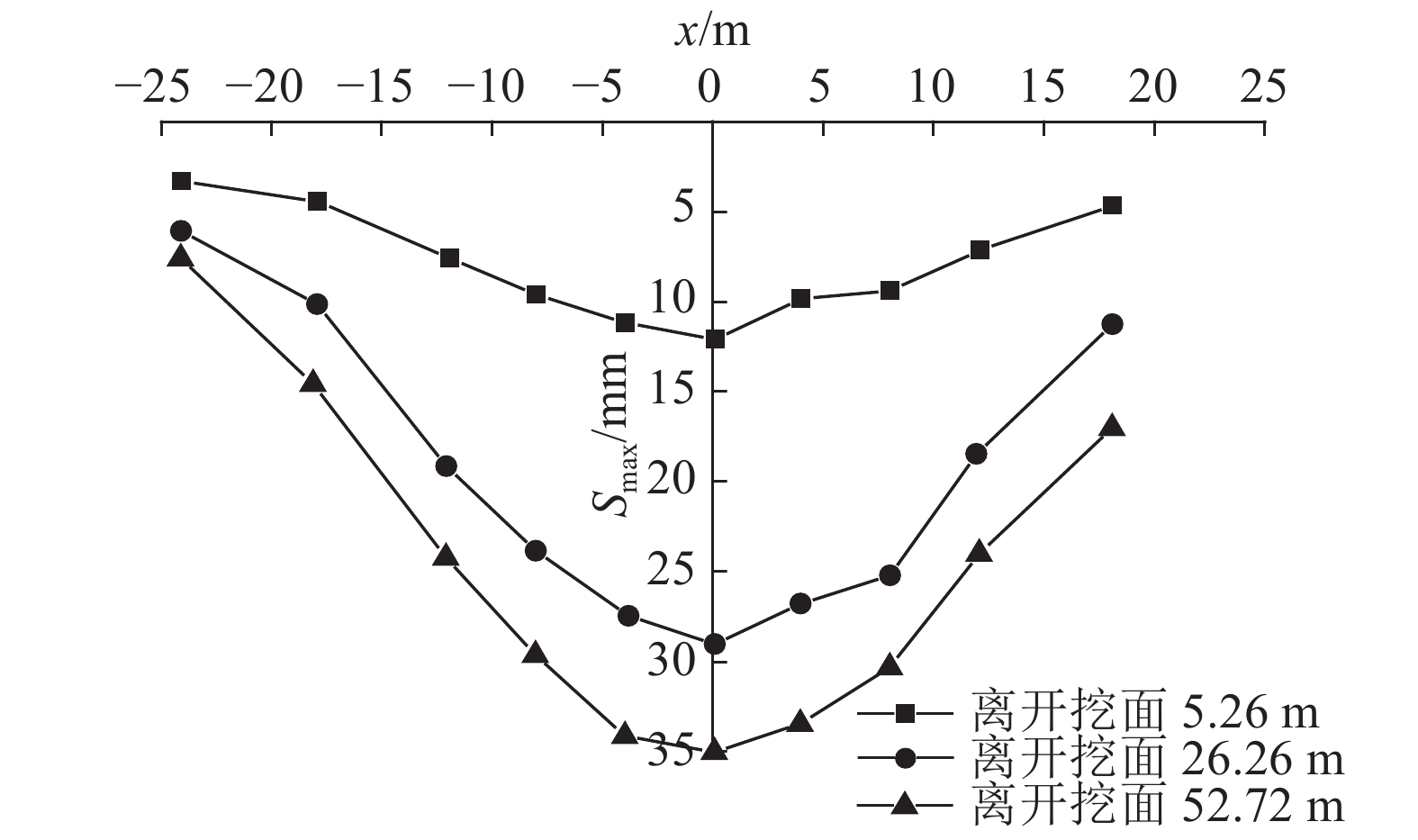
|
图 1 地面横向沉降曲线 Fig. 1 Statistical distribution of ground loss ratio |
将不排水条件取为切口离开挖面26.26 m. 利用Peck公式,分析此时的实测地面沉降数据. 整理图1中离开挖面26.26 m的地面沉降监测数据,绘制
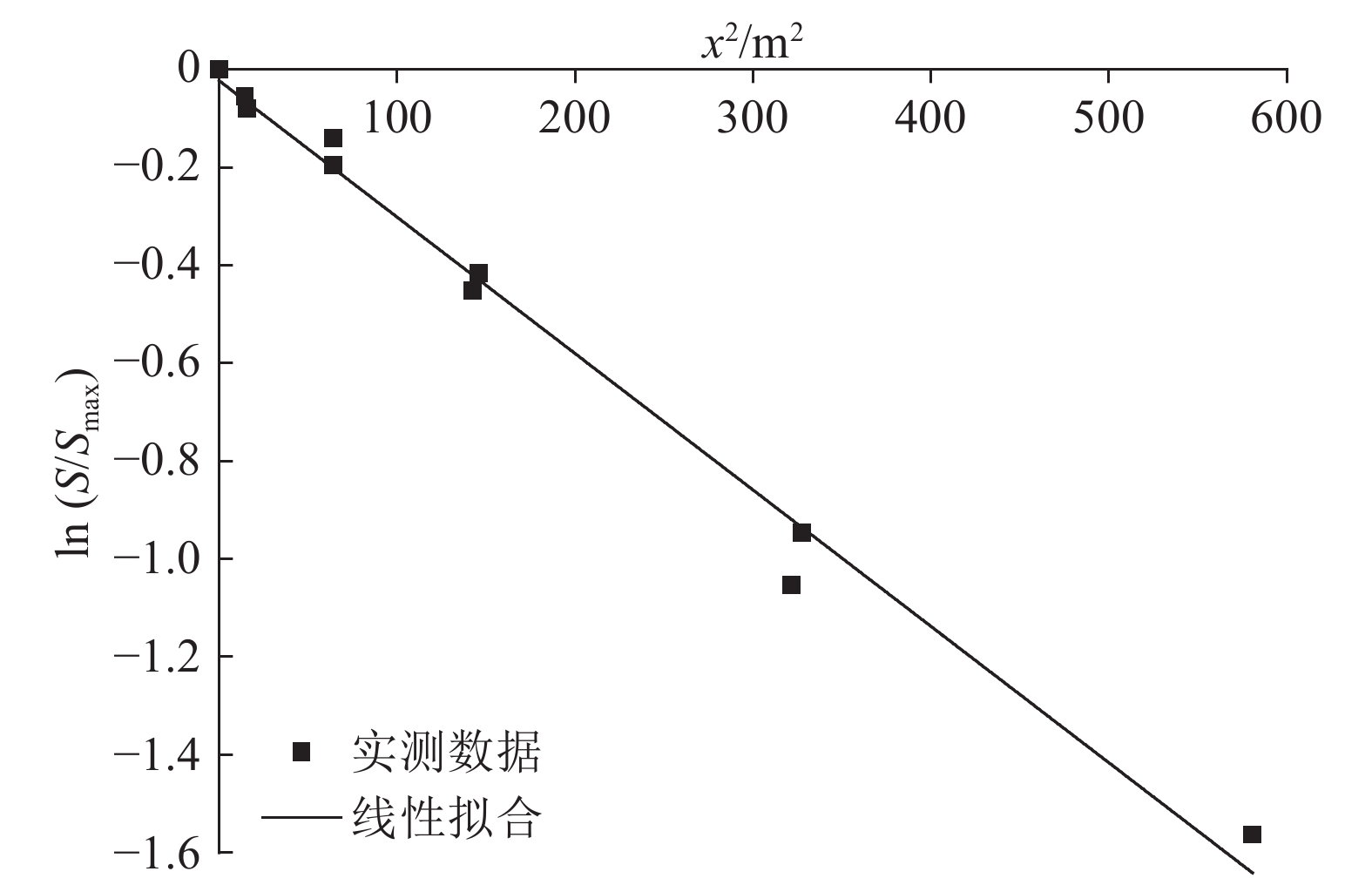
|
图 2 实测数据回归分析 Fig. 2 Statistical distribution of ground loss ratio |
图2中线性拟合的确定系数R2=0.987,表明杭州庆春路大直径泥水平衡盾构隧道施工引起的地面沉降能够利用Peck公式描述. 根据式(7)可得地面沉降槽宽度i=13.39 m,再根据i=kh得到地面沉降槽宽度系数k=0.43,进一步由式(4)求得该断面的地层损失率Vl=0.914%.
对其余收集到的数据进行相同的处理,选取线性拟合R2=0.80以上的数据进行分析. 根据隧道穿越土层的不同,划分为砂土层、砂卵石层、黏土层、黄土层、膨胀土层、岩层以及复合土层. 由于Peck公式的条件是不排水,即不考虑土体的排水固结,将文献[16, 20]的研究结果作为区分施工沉降和固结沉降的依据:取地面沉降随时间变化的沉降速率转折点或盾尾通过后4~8 d作为界限. 具体所收集的数据和反分析结果如表1~3所示. 表1~3中,沉降数据未包含土体固结引起的地层损失率. 表中,H为隧道轴线埋深;D为隧道开挖直径,浅埋暗挖法为等效直径;Smax为地面最大沉降量;Vl为地层损失率;Vlav为地层损失率平均值;k为沉降槽宽度系数;kav为沉降槽宽度系数平均值;g为盾尾注浆率.
| 表 1 土压平衡盾构隧道实测数据反分析结果 Table 1 Back analysis results of measured data from EPB shield |
| 表 2 泥水平衡盾构隧道实测数据反分析结果 Table 2 Back analysis results of measured data from slurry balance shield |
| 表 3 浅埋暗挖隧道实测数据反分析结果 Table 3 Back analysis results of measured data from shallow tunnel construction |
表1~3给出各地区不同隧道施工方法引起的地层损失率和沉降槽宽度系数的范围及平均值,可以为各地区即将建设隧道的设计与预测提供参考. 从表1可得,土压平衡盾构隧道施工引起的地层损失率为0.03%~3.79%,平均值为0.96%,地面沉降槽宽度系数为0.13~0.97,平均值为0.50. 从表2可知,泥水平衡盾构隧道施工引起的地层损失率为0.02%~3.36%,平均值为0.48%;地面沉降槽宽度系数为0.13~0.74,平均值为0.37. 从表3可知,浅埋暗挖隧道施工引起的地层损失率为0.01%~5.32%,平均值为1.20%;地面沉降槽宽度系数为0.21~0.95,平均值为0.54. 如图3所示为不同施工方法引起的地层损失率的统计分布. 图中,PCT为占总数的百分比.
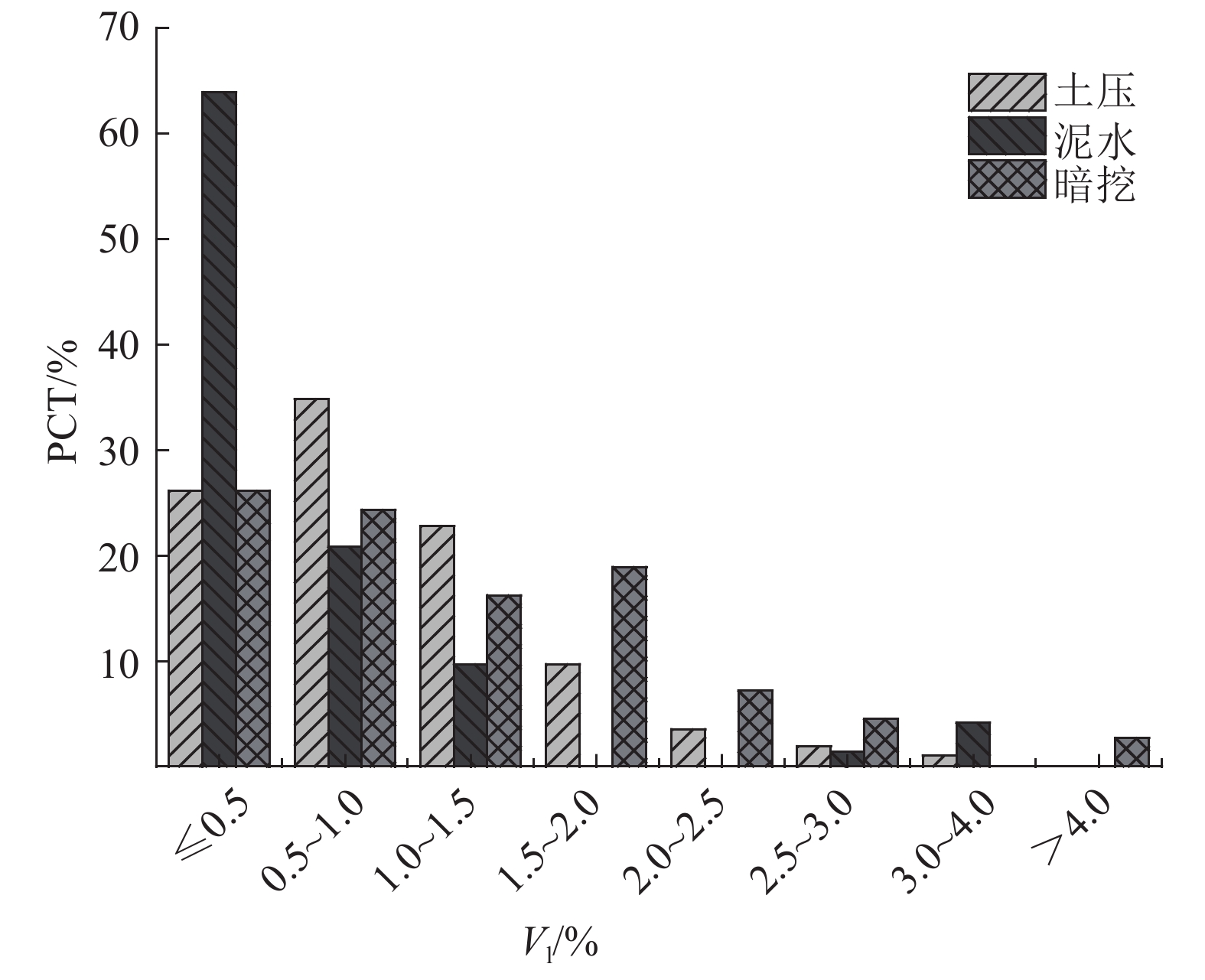
|
图 3 地层损失率统计分布图 Fig. 3 Statistical distribution of ground loss ratio |
如图3所示,土压平衡盾构施工引起的地层损失率为0%~2.0%的概率为93.46%,泥水平衡盾构隧道施工引起的地层损失率分布相对集中,大多集中于0%~0.50%,占总数的近64%;其次集中于0.5%~1.0%,占总数的20.83%. 浅埋暗挖隧道施工引起的地层损失率分布最平均,分布于0%~2.5%的概率达到92.8%. 此外,从地层损失率累计发生概率图(见图4)可知,与土压平衡盾构隧道相比,泥水平衡盾构隧道引起的地层损失率分布更集中,浅埋暗挖隧道引起的地层损失率分布范围更广. 图4中,P为累积发生概率. 表1~3中样本数较少的地区,需要进一步积累相关资料才能更准确地反映当地的地层损失率.
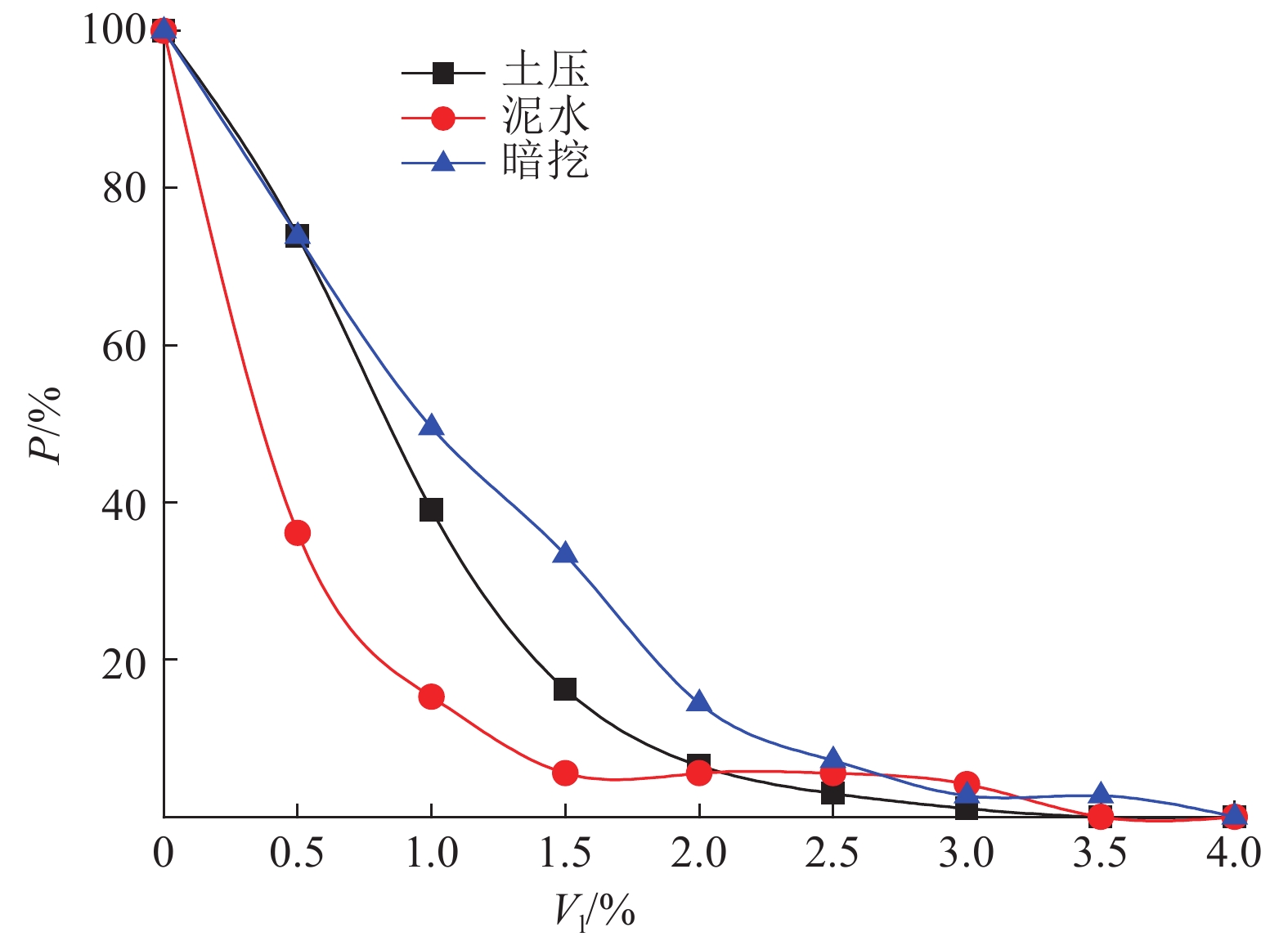
|
图 4 地层损失率累计发生概率 Fig. 4 Accumulative frequency curves of ground loss ratio |
由表2中泥水平衡盾构隧道地层损失率较大的实例可知,Vl=2.51和Vl=3.30的实例主要原因是先施工隧道与后施工隧道的间隔较短,受到后施工隧道的影响较大. Vl=3.36和Vl=3.12的2个实例主要原因是盾构隧道下穿武九铁路,列车频繁通过,对土体施加循环动荷载的影响较大. 由表3中浅埋暗挖隧道地层损失率较大的实例可知,Vl=5.32和Vl=4.43均处于武汉地铁虎泉-名都段,该标段上覆黏土层厚度非常浅薄,自稳性及成拱效应较差,是在雨季施工造成水土流失严重. 由于这些实例的地层损失率明显较大,分析时均未考虑.
1.3 实测数据统计结果的讨论从实测数据分析可以得出,土压平衡盾构隧道的地层损失率和沉降槽宽度系数整体上均大于泥水平衡盾构隧道施工引起的地层损失率和沉降槽宽度系数,浅埋暗挖隧道施工引起的地层损失率分布范围更广,离散性更大.
土压平衡盾构隧道大于泥水平衡盾构隧道的地层损失率,主要原因如下. 1)在隧道施工过程中要对地面变形进行严格监测,使地面沉降在控制值之内. 在相同的地面沉降控制值下,开挖面积越大,地层损失率越小;因此,大直径(D>10 m)泥水平衡盾构隧道必然小于直径约为6 m的土压平衡盾构隧道的地层损失率. 2)大直径泥水平衡盾构隧道的开挖更易引起土体的回弹隆起,从而减小地层损失. 3)在泥水平衡盾构机生产中,对电气和机械等方面进行针对性设计和改进[79].
与盾构法相比,浅埋暗挖隧道施工引起的地层损失率相对较大,分布范围更广,离散性更大,这与朱才辉等[17-18]的研究结果一致. 造成这种现象的原因主要如下:1)浅埋暗挖法允许一定的围岩变形,开挖对围岩的扰动更大;2)浅埋暗挖隧道形状、尺寸、开挖方法、支护措施等多种多样,造成的地面沉降差异较大,地层损失率的分布范围更广;3)浅埋暗挖法的机械化程度低,施工质量人为因素多.
此外,在相同的直径下,地层损失率的规律是浅埋暗挖最大、土压平衡盾构次之、泥水平衡盾构最小. 原因如下:1)浅埋暗挖的机械化程度低,对地层扰动最大;2)土压平衡盾构刀盘切削土体时扭矩较大,对周围地层的扰动比泥水平衡盾构大;3)泥水平衡盾构掘进时易控制,水平、竖直摆动较小.
2 地层损失率影响因素分析为了进一步研究地层损失率的影响因素,将收集到的数据按照隧道开挖断面穿越土层的不同,划分为软土层、砂土层、砂卵石层、膨胀土层、黄土层、岩层及复合土层. 研究不同地层条件、埋径比、注浆率与地层损失率的相关性.
2.1 地层条件与地层损失率的相关性如表4所示为不同地层条件下实测数据的统计结果. 可以看出,土压平衡盾构和浅埋暗挖法引起的地层损失率大体上随着地层条件的变好而减小,泥水平衡盾构引起的地层损失率随着地层渗透系数的变小而减小. 此外,在同一土层条件下,绝大多数都符合利用浅埋暗挖法引起的地层损失率最大,土压平衡盾构次之,泥水平衡盾构最小.
| 表 4 不同地层条件下实测数据统计结果 Table 4 Results of measured data under different soil |
埋径比(H/D)是指隧道轴线埋深H与隧道开挖直径D的比值,浅埋暗挖法采用等效直径. 如图5所示为埋径比与地层损失率的相关性. 可以得出,土压平衡盾构、泥水平衡盾构与浅埋暗挖隧道引起的地层损失率离散性均较大,都难以用有效的函数关系式进行拟合,表明隧道埋径比对地层损失率虽然具有一定的影响,但该单因素的影响较弱.
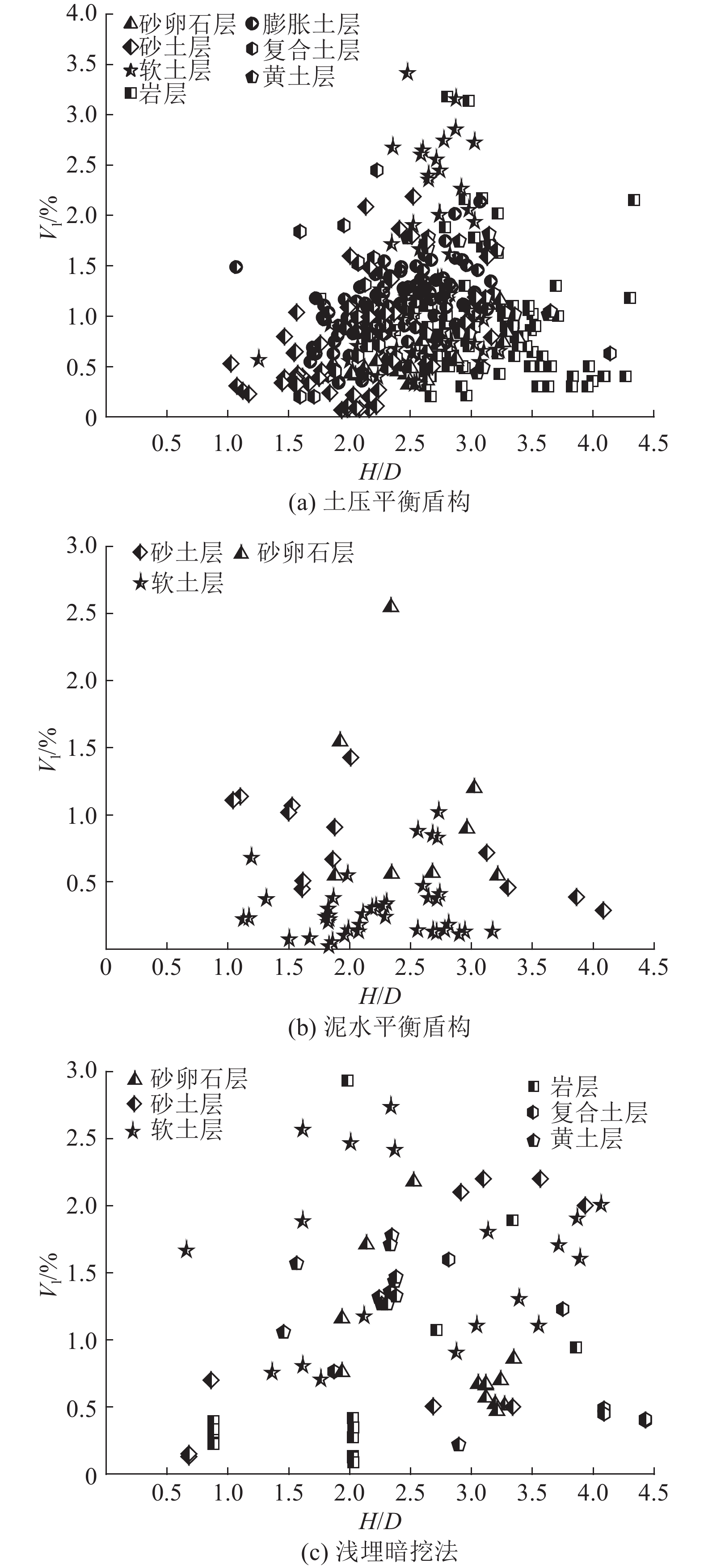
|
图 5 埋径比与地层损失率的关系 Fig. 5 Relationship between ratio of tunnel depth to diameter and ground loss ratio |
如图5(a)所示,土压平衡盾构隧道大部分属于浅埋(1.6<H/D≤2.5)与深埋(2.5≤H/D),很少出现超浅埋(H/D≤1.6)的情况,深埋较浅埋的地层损失率稍大. 地层损失率整体上随着H/D的增加,呈现先增大后减小的趋势. 如图5(b)所示,泥水平衡盾构隧道地层损失率与H/D没有明显的关系,3种埋深情况的地层损失率出现比例相对平均. 可以发现,当H/D>3.0之后整体上开始呈现出减小的趋势. 综合图5(a)、(b),可以认为当H/D<3.0时,盾构隧道施工引起的地层损失率对土体扰动更敏感,更多地受到施工水平的影响;当H/D>3.0之后,盾构隧道地层损失率随着隧道埋径比的增大而减小. 从图5(c)可以发现,浅埋暗挖引起的地层损失率在超浅埋、浅埋和深埋情况下与H/D没有关系,深埋时地层损失率最大. 说明浅埋暗挖法引起的地层损失率更多受到开挖方式、支护措施和施工水平的影响.
2.3 注浆率与地层损失率的相关性注浆率是指实际注入浆液的体积与盾尾理论空隙体积的比值. 如图6所示为注浆率g与地层损失率的相关性. 土压平衡盾构施工引起的地层损失率在相同注浆率下的变化范围较大. 可以看出,不同注浆率下的平均地层损失率随着注浆率的增大,呈现先减小后增大的趋势. 这是因为当注浆率较小(≤200%)时,盾尾注浆的主要作用是填充盾尾空隙,阻止盾构周围土体向隧道方向移动,减小地面沉降,从而降低地层损失率;当注浆率较大(>200%)时,虽然能够提供足够的浆液填充盾尾空隙,但盾尾注浆会对周围土体产生挤压作用,直至劈裂土体,破坏土体结构,增大土体扰动,最终加剧土体沉降,使地层损失率增加.
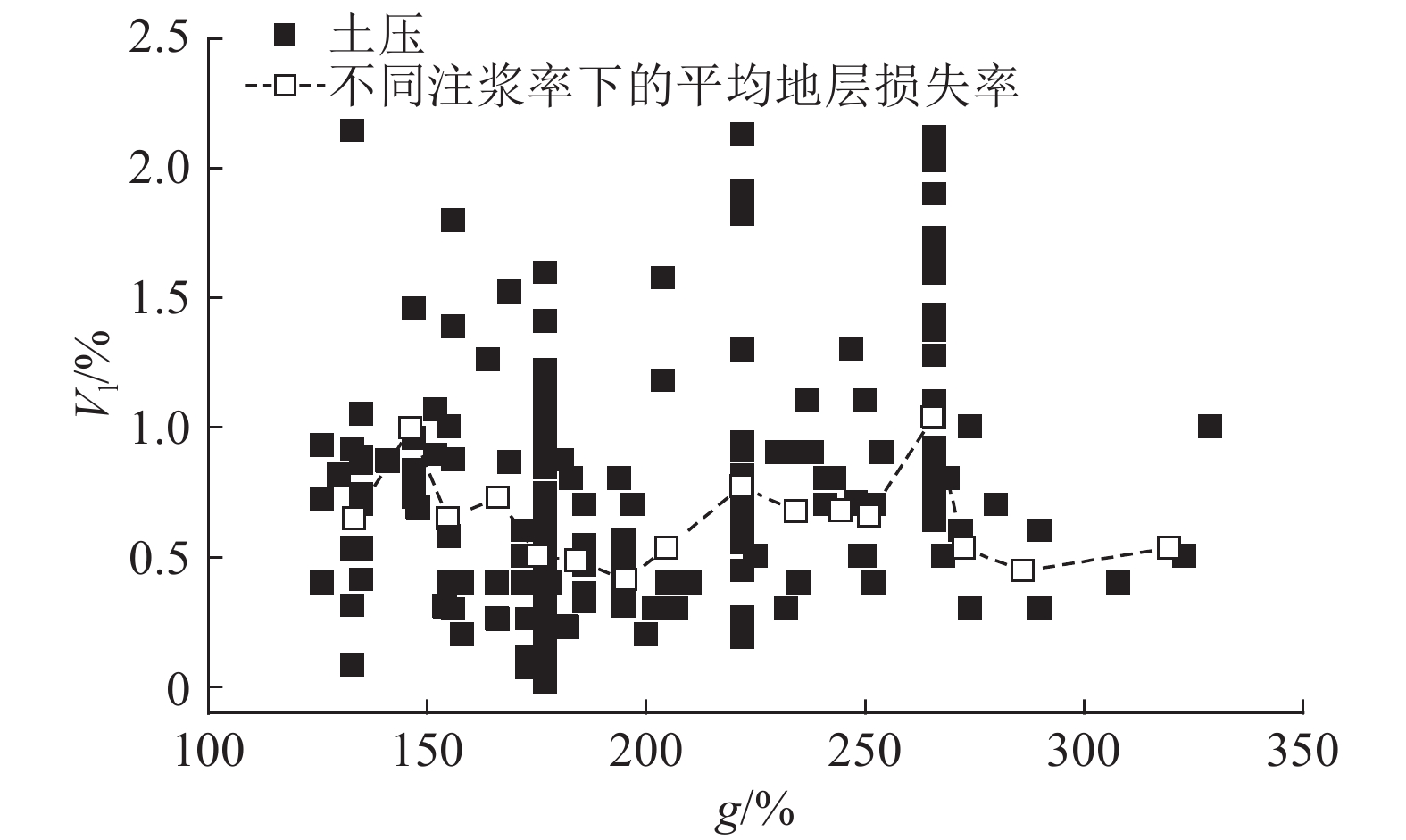
|
图 6 注浆率与地层损失率的关系 Fig. 6 Relationship between grouting ratio and ground loss ratio |
(1)土压平衡盾构、泥水平衡盾构、浅埋暗挖法施工引起的地层损失率平均值分别为0.96%、0.48%、1.20%,分布在0%~2.0%、0%~1.0%、0%~2.5%的概率分别为93.46%、84.83%、92.80%;地面沉降槽宽度系数的平均值分别为0.50、0.37、0.54,分布在0.13~0.97、0.13~0.74、0.21~0.95.
(2)土压平衡盾构大于泥水平衡盾构隧道施工引起的地层损失率,浅埋暗挖隧道施工引起的地层损失率比盾构法的大,分布范围更广,离散性更大.
(3)土压平衡盾构和浅埋暗挖引起的地层损失率基本上随着地层条件的变好而减小,泥水平衡盾构引起的地层损失率随着地层渗透系数的变小而减小.
(4)隧道埋径比与地层损失率的相关性较弱,但总体上,当H/D<3.0时,盾构法(土压、泥水)隧道施工引起的地层损失率对土体扰动更敏感,更多地受到施工水平的影响;在H/D>3.0之后,地层损失率随着隧道埋径比的增大而减小. 浅埋暗挖法引起的地层损失率更多受到开挖方式、支护措施和施工水平的影响.
(5)不同注浆率下的平均地层损失率随着注浆率的增大呈现先减小后增大的趋势,并非注浆率越大越能减小地层损失率.
本文基于隧道施工期间工程实测数据,不考虑土体后期的排水固结,分析不同地层条件下土压平衡盾构、泥水平衡盾构和浅埋暗挖引起地层损失率的分布规律和影响因素,结合当地的施工技术水平和管理水平,研究成果可以为今后相关地区类似隧道工程施工诱发的地面沉降预测和施工控制提供科学参考. 由于有些地区的样本数较少,需要进一步积累数据才能更准确地反映当地的地层损失率,并可以进一步研究盾构类型、隧道线型(直线段和曲线段)、双线隧道开挖、土仓压力、掘进速度、地下水位变化以及浅埋暗挖法中不同施工方法对地层损失率的影响.
| [1] |
HE C, FENG K, FANG Y, et al. Surface settlement caused by twin-parallel shield tunnelling in sandy cobble strata[J]. Journal of Zhejiang University: Science A, 2012, 13(11): 858-869. DOI:10.1631/jzus.A12ISGT6 |
| [2] |
马险峰, 王俊淞, 李削云, 等. 盾构隧道引起地层损失和地表沉降的离心模型试验研究[J]. 岩土工程学报, 2012, 34(5): 942-947. MA Xian-feng, WANG Jun-song, LI Xiao-yun, et al. Centrifuge modeling of ground loss and settlement caused by shield tunnelling in soft ground[J]. Chinese Journal of Geotechnical Engineering, 2012, 34(5): 942-947. |
| [3] |
PECK R B. Deep excavations and tunneling in soft ground [C] // Proceedings of the 7th International Conference on Soil Mechanics and Foundation Engineering. Mexico: Balkema, 1969: 225–290. https://link.springer.com/article/10.1007/BF02591535
|
| [4] |
ROWE R K, LO K Y, KACK G J. A method of estimating surface settlement above tunnels constructed in soft ground[J]. Canadian Geotechnical Journal, 2011, 20(1): 11-22. |
| [5] |
LEE K M, ROWE R K, LO K Y. Subsidence owing to tunneling. I: estimating the gap parameter[J]. Canadian Geotechnical Journal, 1992, 29(6): 929-940. DOI:10.1139/t92-104 |
| [6] |
CLOUGH G W, SCHMIDT B. Design and performance of excavations and tunnels in soft clay[J]. Developments in Geotechnical Engineering, 1981, 20(4): 567-634. |
| [7] |
ATTEWELL P B, YEATES J, SELBY A R. Soil movements induced by tunnel and their effects on pipelines and structures [M]. Glasgow: Blackie, 1986: 10–50.
|
| [8] |
GLOSSOP N H. Ground movements caused by tunnelling in soft soils [D]. Durham: University of Durham, 1978.
|
| [9] |
BROMS B, BENNERMARK H. Stability of clay at vertical openings[J]. Journal of Soil Mechanics and Foundation Engineering Division, 1967, 93(1): 71-94. |
| [10] |
MAIR R J. Settlement effects of bored tunnels [C] // Proceedings of International Symposium on Geotechnical Aspects of Underground Construction in Soft Ground. London: Balkema, 1996: 43–53.
|
| [11] |
ATTEWELL P B, Ground movements caused by tunnelling in soil [C] // Conference on Large Ground Movements and Structures. London: Pentech Press, 1978: 812–948.
|
| [12] |
O’REILLY M P, NEW B M. Settlements above tunnels in the United Kingdom: their magnitude and prediction [C] // Proceedings of Tunnelling 82. London: Institution of Mining and Metallrugy, 1982: 173–181.
|
| [13] |
FARGNOLI V, BOLDINI D, AMOROSI A. TBM tunnel induced settlements in coarse-grained soils: the case of the new Milan underground line 5[J]. Tunnelling and Underground Space Technology, 2013, 38(3): 336-347. |
| [14] |
ZHANG Z X, ZHANG H, YAN J Y. A case study on the behavior of shield tunneling in sandy cobble ground[J]. Environmental Earth Sciences, 2013, 69(6): 1891-1900. DOI:10.1007/s12665-012-2021-4 |
| [15] |
韩煊, 李宁, STANDING J R. Peck公式在我国隧道施工地面变形预测中的适用性分析[J]. 岩土力学, 2007, 28(1): 23-28. HAN Xuan, LI Ning, STANDING J R. An adaptability study of Peck equation applied to predicting ground settlements induced by tunneling in China[J]. Rock and Soil Mechanics, 2007, 28(1): 23-28. DOI:10.3969/j.issn.1000-7598.2007.01.005 |
| [16] |
魏纲. 盾构隧道施工引起的土体损失率取值及分布研究[J]. 岩土工程学报, 2010, 32(9): 1354-1361. WEI Gang. Selection and distribution of ground loss ratio induced by shield tunnel construction[J]. Chinese Journal of Geotechnical Engineering, 2010, 32(9): 1354-1361. |
| [17] |
朱才辉, 李宁. 地铁施工诱发地表最大沉降量估算及规律分析[J]. 岩石力学与工程学报, 2017, 36(增1): 3543-3560. ZHU Cai-hui, LI Ning. Estimation and regularity analysis of maximal surface settlement induced by subway construction[J]. Chinese Journal of Rock Mechanics and Engineering, 2017, 36(增1): 3543-3560. |
| [18] |
朱才辉, 李宁. 隧道施工诱发地表沉降估算方法及其规律分析[J]. 岩土力学, 2016, 38(增2): 533-542. ZHU Cai-hui, LI Ning. Estimation method and laws analysis of surface settlement due to tunneling[J]. Rock and Soil Mechanics, 2016, 38(增2): 533-542. |
| [19] |
MAIR R J, TAYLOR R N, BRACEGIRDLE A. Subsurface settlement profiles above tunnels in clays[J]. Geotechnique, 1993, 43(2): 315-320. DOI:10.1680/geot.1993.43.2.315 |
| [20] |
张忠苗, 林存刚, 吴世明, 等. 泥水盾构施工引起的地面固结沉降实例研究[J]. 浙江大学学报: 工学版, 2012, 46(3): 431-440. ZHANG Zhong-miao, LIN Cun-gang, WU Shi-ming, et al. Case study of ground surface consolidation settlements induced by slurry shield tunneling[J]. Journal of Zhejiang University: Engineering Science, 2012, 46(3): 431-440. |
| [21] |
徐小马. Peck公式在合肥地区的适用性分析及临近既有深基础盾构施工地面沉降研究[D]. 合肥: 合肥工业大学, 2016. XU Xiao-ma. Applicability analysis of Gauss formula in Hefei area and study on the ground subsidence of shield construction near the deep foundation [D]. Hefei: Hefei University of Technology, 2016. http://cdmd.cnki.com.cn/Article/CDMD-10359-1016195037.htm |
| [22] |
代朋飞. 合肥地铁盾构法施工引起地表沉降的分析与数值模拟[D]. 合肥: 安徽建筑大学, 2016. DAI Peng-fei. Analysis and numerical simulation on ground settlements caused by shield driven method construction in Hefei Metro [D]. Hefei: Anhui Jianzhu University, 2016. http://cdmd.cnki.com.cn/Article/CDMD-10878-1016198498.htm |
| [23] |
杨三资, 张顶立, 王剑晨, 等. 北京黏性土地层大直径土压平衡盾构施工地层变形规律研究[J]. 土木工程学报, 2015, 48(增1): 297-301. YANG San-zi, ZHANG Ding-li, WANG Jian-chen, et al. Ground deformation characteristic due to large diameter slurry shield construction in clay in Beijing[J]. China Civil Engineering Journal, 2015, 48(增1): 297-301. |
| [24] |
郭玉海. 大直径土压平衡盾构引起的地表变形及掘进控制技术研究[D]. 北京: 北京交通大学, 2014. GUO Yu-hai. Study on big diameter earth pressure balance shield tunneling induced ground surface movements and corresponding driving control technologies [D]. Beijing: Beijing Jiaotong University, 2014. http://cdmd.cnki.com.cn/Article/CDMD-10004-1014369243.htm |
| [25] |
李淼. 建筑物对盾构隧道施工引起地面沉降模式的影响[J]. 工程勘察, 2009, 37(06): 30-33. LI Miao. Influence of existing structures on ground movement induced by shield tunnel[J]. Geotechnical Investigation and Surveying, 2009, 37(06): 30-33. |
| [26] |
陈枫. 隧道开挖引起地表沉降的解析研究[D]. 上海: 同济大学, 2004. CHEN Feng. Analytical study of ground settlement induced by shield tunnel [D]. Shanghai: Tongji University, 2004. http://www.wanfangdata.com.cn/details/detail.do?_type=degree&id=Y675347 |
| [27] |
侯永茂, 郑宜枫, 杨国祥, 等. 超大直径土压平衡盾构施工对环境影响的现场监测研究[J]. 岩土力学, 2013, 34(1): 235-242. HOU Yong-mao, ZHENG Yi-feng, YANG Guo-xiang, et al. Measurement and analysis of ground settlement due to EPB shield construction[J]. Rock and Soil Mechanics, 2013, 34(1): 235-242. |
| [28] |
周文波. 超大直径土压平衡盾构在中心城区公路隧道中的应用技术探讨[J]. 现代隧道技术, 2013, 50(3): 1-7. ZHOU Wen-bo. Discussion of the application of extra-large diameter EPB shields to road tunnels in central urban areas[J]. Modern Tunnelling Technology, 2013, 50(3): 1-7. DOI:10.3969/j.issn.1009-6582.2013.03.001 |
| [29] |
纪梅, 谢雄耀. 大直径土压平衡盾构掘进引起的地表沉降分析[J]. 地下空间与工程学报, 2012, 8(1): 161-166. JI Mei, XIE Xiong-yao. Numerical simulation analysis of ground surface settlement caused by large diameter EPB shield tunneling[J]. Chinese Journal of Underground Space and Engineering, 2012, 8(1): 161-166. |
| [30] |
杨芬. 宁波轨道交通盾构施工引起的长期沉降特性研究[D]. 宁波: 宁波大学, 2015. YANG Fen. Study on the long term settlement characteristics caused by shield construction in Ningbo Rail Transit [D]. Ningbo: Ningbo University, 2015. http://cdmd.cnki.com.cn/Article/CDMD-11646-1015804279.htm |
| [31] |
卢昌龙. 南京地铁隧道盾构法施工地表沉降数值模拟研究[D]. 合肥: 安徽理工大学, 2014. LU Chang-long. Numerical simulation analysis of surface settlement caused by Nanjing subway construction [D]. Hefei: Anhui University of Science and Technology, 2014. http://cdmd.cnki.com.cn/Article/CDMD-10361-1014384812.htm |
| [32] |
郭延华, 吴龙海. 南京地层地铁隧道施工的Peck公式修正[J]. 河北工程大学学报: 自然科学版, 2013, 30(01): 41-44. GUO Yan-hua, WU Long-hai. The correction of Peck formula in subway tunnel under Nanjing Stratum[J]. Journal of Hebei University of Engineering: Natural Science Edition, 2013, 30(01): 41-44. |
| [33] |
王庆. 成都地铁盾构施工对周边环境的影响研究[D]. 成都: 西南交通大学, 2009. WANG Qing. Study on the influence applied to surrounding environment induced by the construction of tunnel of Chengdu metro [D]. Chengdu: Southwest Jiaotong University, 2009. http://cdmd.cnki.com.cn/Article/CDMD-10613-2009218973.htm |
| [34] |
杨期祥. 成都地铁砂卵石层盾构开挖引起的地表沉降规律分析[D]. 成都: 西南交通大学, 2016. YANG Qi-xiang. Study on the regularity of surface settlement caused by shield tunnel in Chengdu sandy pebble stratum [D]. Chengdu: Southwest Jiaotong University, 2016. http://cdmd.cnki.com.cn/Article/CDMD-10613-1016170787.htm |
| [35] |
章慧健, 仇文革, 王庆. 城市地铁盾构施工引起的地表沉降分析[J]. 铁道建筑, 2009, 49(09): 64-67. ZHANG Hui-jian, CHOU Wen-ge, WANG Qing. Analysis of ground settlement induced by shield tunnel in subway[J]. Railway Engineering, 2009, 49(09): 64-67. DOI:10.3969/j.issn.1003-1995.2009.09.021 |
| [36] |
白海卫, 宋守信, 王剑晨. Peck公式在双线盾构隧道施工地层变形中的适应性分析[J]. 北京交通大学学报, 2015, 39(3): 30-34. BAI Hai-wei, SONG Shou-xin, WANG Jian-chen. Adaptability study of Peck applied to predicting ground settlement induced by double shield tunnel[J]. Journal of Beijing Jiaotong University, 2015, 39(3): 30-34. |
| [37] |
陈自海, 杨建辉, 郭小东, 等. 软土地层中盾构施工参数对地表沉降的影响研究[J]. 隧道建设, 2015, 35(12): 1281-1286. CHEN Zi-hai, YANG Jian-hui, GUO Xiao-dong, et al. Study on influence of soft ground shield tunnel parameter on ground surface settlement[J]. Tunnel Construction, 2015, 35(12): 1281-1286. DOI:10.3973/j.issn.1672-741X.2015.12.008 |
| [38] |
渠开胜. 软土地层中盾构施工引起地表沉降规律研究[D]. 杭州: 浙江工业大学, 2014. QU Kai-sheng. Research on the low of ground settlement by shield construction of metro tunnel in soft soil [D]. Hangzhou: Zhejiang University of Technology, 2014. http://cdmd.cnki.com.cn/Article/CDMD-10337-1015502598.htm |
| [39] |
唐晓武, 朱季, 刘维, 等. 盾构施工过程中的土体变形研究[J]. 岩石力学与工程学报, 2010, 29(2): 417-422. TANG Xiao-wu, ZHU Ji, LIU Wei, et al. Research on soil deformation during shield construction process[J]. Chinese Journal of Rock Mechanics and Engineering, 2010, 29(2): 417-422. |
| [40] |
颜治国. 西安地铁黄土地层中盾构隧道地表沉降控制理论与技术[D]. 北京: 中国矿业大学, 2012. YAN Zhi-guo. Research on the controlling theory and technology of excavation in loess stratigraphy in Xi'an metro [D]. Beijing: China University of Mining and Technology, 2012. http://cdmd.cnki.com.cn/Article/CDMD-11413-1013132045.htm |
| [41] |
江杰, 李弈杉, 卢鹏, 等. 盾构隧道施工引起地表沉降的Peck公式预测方法修正[J]. 广西大学学报: 自然科学版, 2017, 42(1): 236-242. JIANG Jie, LI Yi-shan, LU Peng, et al. Correction of Peck formula based on surface subsidence caused by shield tunneling in Nanning[J]. Journal of Guangxi University: Natural Science Edition, 2017, 42(1): 236-242. |
| [42] |
李弈杉. 南宁地铁盾构隧道施工引起的地表沉降规律研究[D]. 南宁: 广西大学, 2016. LI Yi-shan. Study on the law of ground settlement caused by shield tunnel construction in Nanning [D]. Nanning: Guangxi University, 2016. http://cdmd.cnki.com.cn/Article/CDMD-10593-1017041170.htm |
| [43] |
徐明辉. 膨胀岩土条件下盾构施工沉降研究[D]. 广州: 暨南大学, 2016. XU Ming-hui. Research on settlement of shield construction in expansion rock and soil [D]. Guangzhou: Jinan University, 2016. http://cdmd.cnki.com.cn/Article/CDMD-10559-1016734443.htm |
| [44] |
麻凤海, 赵阳豪. 地铁盾构施工引起的地表沉降预测[J]. 地震研究, 2016, 39(01): 10-14. MA Feng-hai, ZHAO Yang-hao. Study on prediction of ground surface settlement caused by subway shied tunneling construction[J]. Journal of Seismological Research, 2016, 39(01): 10-14. DOI:10.3969/j.issn.1000-0666.2016.01.002 |
| [45] |
郑馨, 麻凤海. 长春地层地铁隧道施工的Peck公式改进[J]. 地下空间与工程学报, 2017, 13(03): 732-736. ZHENG Xin, MA Feng-hai. Improvement of Peck formula in subway construction in Changchun[J]. Chinese Journal of Underground Space and Engineering, 2017, 13(03): 732-736. |
| [46] |
张忠苗, 林存刚, 吴世明, 等. 过江盾构隧道穿越大堤的地层沉降分析及控制[J]. 岩土工程学报, 2011, 33(6): 977-984. ZHANG Zhong-miao, LIN Cun-gang, WU Shi-ming, et al. Analysis and control of ground settlement of embankment in construction of cross-river shield tunnels[J]. Chinese Journal of Geotechnical Engineering, 2011, 33(6): 977-984. |
| [47] |
LIN C G, ZHANG Z M, WU S M, et al. Key techniques and important issues for slurry shield under-passing embankments: a case study of Hangzhou Qiantang River Tunnel[J]. Tunnelling and Underground Space Technology, 2013, 38(9): 306-325. |
| [48] |
陈有亮, 周雪莲, 李林, 等. 超大直径盾构施工地表沉降实测数据分析[J]. 力学季刊, 2013, 34(4): 614-620. CHEN You-liang, ZHOU Xue-lian, LI Lin, et al. Research on ground settlement due to extra-large diameter shield construction[J]. Chinese Quarterly of Mechanics, 2013, 34(4): 614-620. DOI:10.3969/j.issn.0254-0053.2013.04.014 |
| [49] |
李庭平. 影响泥水平衡盾构施工中变形的因素分析及其对既有隧道影响的分析[D]. 上海: 上海交通大学, 2008. LI Ting-ping. Analysis of deformation factors during construction of slurry type shield tunnels with the effects on existing metro tunnel [D]. Shanghai: Shanghai Jiaotong University, 2008. |
| [50] |
伍振志, 杨国祥, 杨林德, 等. 上海长江隧道过民房段地表变位预测及控制研究[J]. 岩土力学, 2010, 31(2): 582-587. WU Zhen-zhi, YANG Guo-xiang, YANG Lin-de, et al. Prediction and control of ground movement of Shanghai Yangtze River tunneling across building areas[J]. Rock and Soil Mechanics, 2010, 31(2): 582-587. DOI:10.3969/j.issn.1000-7598.2010.02.041 |
| [51] |
程磊标, 陈有亮, 王苏然, 等. 超大直径盾构施工地表沉降分析[J]. 水资源与水工程学报, 2017, 28(01): 226-229. CHENG Lei-biao, CHEN You-liang, WANG Su-ran, et al. Analysis of ground surface settlement induced by the super diameter shield[J]. Journal of Water Resources and Water Engineering, 2017, 28(01): 226-229. |
| [52] |
马可栓. 盾构施工引起地基移动与近邻建筑保护研究[D]. 武汉: 华中科技大学, 2008. MA Ke-shuan. Research on the ground settlement caused by the shield construction and protection [D]. Wuhan: Huazhong University of Science and Technology, 2008. http://cdmd.cnki.com.cn/Article/CDMD-10248-2008053028.htm |
| [53] |
肖龙鸽, 王超峰, 赵运臣. 大直径泥水盾构施工引起的地表沉降分析和对策[J]. 现代隧道技术, 2008, 45(5): 50-58. XIAO Long-ge, WANG Chao-feng, ZHAO Yun-chen. Analysis of surface settlements caused by large-diameter slurry shield driving and countermeasures[J]. Modern Tunnelling Technology, 2008, 45(5): 50-58. DOI:10.3969/j.issn.1009-6582.2008.05.010 |
| [54] |
季大雪. 武汉长江隧道盾构下穿武九铁路沉降影响分析[J]. 铁道工程学报, 2009, 26(10): 59-63. JI Da-xue. Analysis of the influence of underpass shield of Wuhan Yangtze River tunnel on settlement of Wuhan- Jiujiang railway[J]. Journal of Railway Engineering Society, 2009, 26(10): 59-63. DOI:10.3969/j.issn.1006-2106.2009.10.015 |
| [55] |
李国成, 丁烈云. 武汉长江隧道盾构施工引起的地表沉降预测[J]. 铁道工程学报, 2008, 25(5): 59-62. LI Guo-cheng, DING Lie-yun. Ground settlement induced by shield construction of Wuhan Yangtze River Tunnel[J]. Journal of Railway Engineering Society, 2008, 25(5): 59-62. DOI:10.3969/j.issn.1006-2106.2008.05.014 |
| [56] |
王渊. 盾构施工引起的地面沉降及周边建筑物保护[D]. 武汉: 华中科技大学, 2008. WANG Yuan. Research on ground subsidence caused by shield-driven construction and buildings protection [D]. Wuhan: Huazhong University of Science and Technology, 2008. http://cdmd.cnki.com.cn/Article/CDMD-10487-2009144331.htm |
| [57] |
肖衡. 大直径泥水盾构掘进对土体的扰动研究[D]. 北京: 北京交通大学, 2009. XIAO Heng. Study on soil disturbance caused by large diameter slurry shield tunneling [D]. Beijing: Beijing Jiaotong University, 2009. http://cdmd.cnki.com.cn/Article/CDMD-10004-2009146267.htm |
| [58] |
梅逸飞. 盾构法施工隧道监测监控技术研究[D]. 武汉: 武汉理工大学, 2013. MEI Yi-fei. Research on monitoring technology in shield tunnel construction [D]. Wuhan: Wuhan University of Technology, 2013. http://cdmd.cnki.com.cn/Article/CDMD-10497-1013296279.htm |
| [59] |
房倩, 王剑晨, 刘翔, 等. 超大直径泥水式盾构施工地层变形规律研究[J]. 现代隧道技术, 2017, 54(03): 120-125. FANG Qian, WANG Jian-chen, LIU Xiang, et al. Characteristics of ground deformation induced by large-diameter slurry shield construction[J]. Modern Tunnelling Technology, 2017, 54(03): 120-125. |
| [60] |
戴洪伟. 瘦西湖超大直径盾构隧道施工对周边环境影响分析[J]. 隧道建设, 2015, 35(4): 316-321. DAI Hong-wei. Influence of super-large diameter shield tunneling on surrounding environment: case study on Slender West Lake crossing tunnel in Yangzhou, China[J]. Tunnel Construction, 2015, 35(4): 316-321. |
| [61] |
陈健. 扬州瘦西湖盾构隧道施工关键技术与实测分析[J]. 建筑施工, 2015, 37(03): 361-364. CHEN Jian. Key technology and actual measurement analysis of shield tunnel construction of Yangzhou Slender West Lake[J]. Building Construction, 2015, 37(03): 361-364. |
| [62] |
秦世朋. 大直径泥水盾构隧道施工地层响应分析[D]. 北京: 北京交通大学, 2015. QIN Shi-peng. Analysis of ground response induced by large slurry shield tunnel [D]. Beijing: Beijing Jiaotong University, 2015. |
| [63] |
杨延栋, 陈馈, 李凤远, 等. 狮子洋隧道陆地段盾构施工横向地表沉降研究[J]. 隧道建设, 2014, 34(12): 1143-1147. YANG Yan-dong, CHEN Kui, LI Feng-yuan, et al. Case study on transverse ground surface settlement of land section of Shiziyang tunnel bored by shield[J]. Tunnel Construction, 2014, 34(12): 1143-1147. DOI:10.3973/j.issn.1672-741X.2014.12.005 |
| [64] |
李继升. 北京地铁浅埋暗挖法施工引起地表沉降规律的研究[D]. 北京: 中国地质大学(北京), 2012. LI Ji-sheng. Beijing subway mining method due to construction of ground settlement [D]. Beijing: China University of Geosciences, 2012. |
| [65] |
马从铭. 北京某商业区浅埋暗挖通道开挖沉降规律的研究[D]. 北京: 中国地质大学(北京), 2016. MA Cong-ming. Study on the settlement law of shallow excavation tunnel excavation in a commercial area of Beijing [D]. Beijing: China University of Geosciences, 2016. http://cdmd.cnki.com.cn/Article/CDMD-11415-1016068321.htm |
| [66] |
荆龙飞. 地铁浅埋暗挖施工引起地表沉降规律研究[D]. 西安: 西安建筑科技大学, 2013. XING Long-fei. Study on law of ground surface deformation in shallow tunnel excavation [D]. Xi’an: Xi’an University of Architecture and Technology, 2013. http://cdmd.cnki.com.cn/Article/CDMD-10703-1014010884.htm |
| [67] |
杨子奇. 流固耦合作用下北京朝阳区富水地层隧道施工的力学效应研究[D]. 北京:中国地质大学(北京), 2017. YANG Zi-qi. Study on mechanics effect of tunnelling construction in Chaoyang district based on fluid-solid interaction effect [D]. Beijing: China University of Geosciences, 2017. http://cdmd.cnki.com.cn/Article/CDMD-11415-1017129788.htm |
| [68] |
李倩倩, 张顶立, 房倩, 等. 浅埋暗挖法下穿既有盾构隧道的变形特性分析[J]. 岩石力学与工程学报, 2014, 33(增2): 3911-3918. LI Qian-qian, ZHANG Ding-li, FANG Qian, et al. Study of deformation characteristics of tunnels transersing adjacently under shield tunnels by shallow tunneling method[J]. Chinese Journal of Rock Mechanics and Engineering, 2014, 33(增2): 3911-3918. |
| [69] |
李洋. 西安地铁浅埋暗挖法施工地层变形研究[D]. 西安: 长安大学, 2015. LI Yang. Research on stratum deformation of shallow-buried undercut metro tunnel in Xi’an [D]. Xi’an: Chang’an University, 2015. http://cdmd.cnki.com.cn/Article/CDMD-10710-1015803227.htm |
| [70] |
佘芳涛, 韩日美, 刘庚, 等. 西安地铁双线隧道地表沉降预测模型研究[J]. 防灾减灾工程学报, 2011, 31(5): 560-566. SHE Fang-tao, HAN Ri-mei, LIU Geng, et al. Research on calculation model of settlement trough of Xi'an subway with double lines[J]. Journal of Disaster Prevention and Mitigation Engineering, 2011, 31(5): 560-566. |
| [71] |
李攀. 西安地铁暗挖隧道地表沉降的监测分析研究[D]. 西安: 西安理工大学, 2012. LI Pan. Analysis of ground surface settlement induced by shallow buried tunnel in Xi’an metro [D]. Xi’an: Xi'an University of Technology, 2012. |
| [72] |
胡斌, 刘永林, 唐辉明, 等. 武汉地铁虎泉-名都区间隧道开挖引起的地表沉降研究[J]. 岩石力学与工程学报, 2012, 31(5): 908-913. HU Bin, LIU Yong-lin, TANG Hui-ming, et al. Research on ground subsidence due to tunnel excavation in Huquan-Mingdu section of Wuhan subway[J]. Chinese Journal of Rock Mechanics and Engineering, 2012, 31(5): 908-913. DOI:10.3969/j.issn.1000-6915.2012.05.006 |
| [73] |
杨珺博. 应力释放与开挖方法对隧道支护受力及地表沉降的影响[D]. 湘潭: 湘潭大学, 2011. YANG Jun-bo. The effect on tunnel support structure and ground settlement by stress release and excavation method [D]. Xiangtan: Xiangtan University, 2011. http://cdmd.cnki.com.cn/Article/CDMD-10530-1011243185.htm |
| [74] |
刘波, 陶龙光, 叶圣国, 等. 地铁隧道施工引起地层变形的反分析预测系统[J]. 中国矿业大学学报, 2004, 33(3): 277-282. LIU Bo, TAO Long-guang, YE Sheng-guo, et al. Back analysis prediction system for ground deformation due to subway tunneling excavation[J]. Journal of China University of Mining and Technology, 2004, 33(3): 277-282. DOI:10.3321/j.issn:1000-1964.2004.03.010 |
| [75] |
闫海生. 典型地质条件下地铁施工引起地表沉降规律的研究[D]. 太原: 太原理工大学, 2011. YAN Hai-sheng. Study on ground subsidence regularity caused by subway construction under the typical geological conditions [D]. Taiyuan: Taiyuan University of Technology, 2011. http://cdmd.cnki.com.cn/Article/CDMD-10112-1011081992.htm |
| [76] |
万姜林, 潘明亮, 李治国. 浅埋单洞双层重叠隧道施工引起的地表与支护结构变形分析[C]//中国土木工程学会第 11 届年会暨隧道及地下工程分会第 13 届年会. 北京:中铁西南科学研究院, 2004: 24–29. WAN Jiang-lin, PAN Ming-liang, LI Zhi-guo. Analysis on ground and supporting structure deformation induced by tunneling construction in overlapped single tunnels [C] // The 11th Meeting of China Civil Engineering Society-the 13th Annual Meeting of Tunnel and Underground Engineering Branch. Beijing: China Railway Southwest Research Institute Limited Company, 2004: 24–29. http://cpfd.cnki.com.cn/Article/CPFDTOTAL-OGTY200411001005.htm |
| [77] |
施成华, 彭立敏, 刘宝琛. 浅埋隧道开挖对地表建筑物的影响[J]. 岩石力学与工程学报, 2004, 23(19): 3310-3316. SHI Cheng-hua, PENG Li-min, LIU Bao-chen. Influence of shallow tunnel excavation on ground surface buildings[J]. Chinese Journal of Rock Mechanics and Engineering, 2004, 23(19): 3310-3316. DOI:10.3321/j.issn:1000-6915.2004.19.017 |
| [78] |
姚爱军, 卢健, 邱忠旺, 等. 土岩复合地层中地铁施工Peck沉降预测公式改进[J]. 铁道建筑, 2016, 56(6): 83-87. YAO Ai-jun, LU Jian, QIU Zhong-wang, et al. Improving of Peck's settlement calculation formula related to metro tunnel construction in soil-rock composite stratum[J]. Railway Engineering, 2016, 56(6): 83-87. DOI:10.3969/j.issn.1003-1995.2016.06.23 |
| [79] |
羌培. 超大直径土压平衡盾构最佳施工参数匹配研究[D]. 上海: 上海大学, 2015. QIANG Pei. The research of perfect matching of tunneling parameter for super large diameter earth pressure balance machine [D]. Shanghai: Shanghai University, 2015. http://cdmd.cnki.com.cn/Article/CDMD-10280-1015640454.htm |



